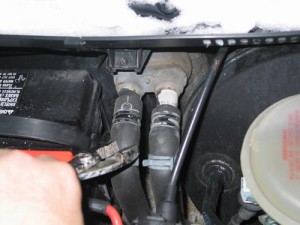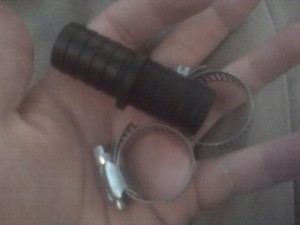A couple of weeks back, my better half learned that FWD hybrid cars aren’t very good off-road.
It had been raining – hard – for more than 24 hours. The ground was a gushy mess. She made the mistake of trying to turn a hybrid Lexus ES around by briefly (or so she thought it would be) driving onto the gushy ground – whereupon the car sank to its rocker panels in said gushy ground, as helpless as Ned Beatty in that scene – you know the one. Now, there are several ways to get a stuck car unstuck – “by the book” and otherwise.
I went with otherwise.
Because the last thing I wanted to do was root around in the muck trying to find the tow hooks – which were down there somewhere . . . like Titanic’s water line, buried far from the sight of man (to say nothing of man’s hands). Not in the pouring rain. Not at 8:30 p.m. Instead, I fired up my 4×4 truck – and grabbed a heavy cushion from the old sofa I keep in my outbuilding. With the truck in Low, I inched it to within inches of the rear end of the Ned Beatty’fied Lexus hybrid. Got out, put that heavy cushion in between the two. You can probably see where I am going with this. Told wife – who is piloting “Ned” – to mash the gas when she hears me toot my horn. Then I gently, gradually, eased the truck forward. At contact, I hit the horn – and she hit the gas. With a little help from behind, the Lexus heaved-to and was shortly free of the muck. No harm done – and no fuss (although some muss). I tell this tale as an example of field-expedient problem solving of automotive debacles. It’s not by the book, maybe – but it works. And isn’t that the thing?
Here’s another couple that may prove helpful to you sometime down the road:
* Heater core end-run –
You’re driving along and begin to notice a sticky, hazy film on the inside of the windshield – and there’s a sticky (and warm and wet) mess burbling up on the passenger side carpet. What’s happened is the heater core’s done sprung a leak. Warm coolant is leaking inside the car – and anti-freeze saturated warm vapors are circulating through the HVAC vents – hence the sticky film on the windshield. The quick fix is the automotive equivalent of tying off an artery. Under the hood, you will find two hoses – smaller in diameter than the main two (upper and lower) radiator hoses at the front of the engine, but still good sized. These are the hoses that carry warm coolant to – and from – the heater core, which is buried deep inside the firewall area (typically). What you want to do is splice these two hoses together – cutting the heater core out of the circulatory loop. Sometimes, you can just cut one and plumb the open end of that hose onto the fitting (at the engine) for the other hose. Or get a little plastic tube of just slightly smaller diameter – and use it to connect the cut ends of both hoses together, using radiator clamps to secure them. Radiator flush n’ fill kits – sold at any auto parts store have exactly the part (the little plastic joiner tube) you’ll be needing. Once done, you can drive the car that way indefinitely. No harm will come – but you will be cold (if it’s winter) because there will be no heat – until you have the heater core repaired/replaced. But, at least you won’t be stuck.
* Fuse shuffle –
Remember the second Terminator movie? There’s a scene near the end where the old model (Arnold) gets trashed by the new model (the liquid metal dude)? You think it’s lights out, but the Arnold Terminator re-routes its circuits and comes back to life just in time to save John Connor. Well, there’s a lesson in that. Let’s say you’re driving along and your car goes lights out – just dies on you. There are many things that might cause this to happen, but one of the things that could have happened that’s (fingers crossed) fixable by the side of the road is a blown fuse for a critical circuit. This is the first thing to check, before you call AAA. If you don’t know where the fuse panel is, find your owner’s manual – it should not only tell you where (someplace near the steering wheel is typical) but also have a diagram showing you the fuse map – which ones go where and what each one protects. Open the little panel and look carefully at each fuse. If the little metal strip embedded in the translucent plastic is burned through (from an overload or power surge) it will be obvious. Most fuse panels will have a little plastic tool that looks like a set of tweezers. Use it to pull the dead fuse. Hopefully, the maker of your car will also have provided a few extra/emergency fuses. Find the right one (by color and by matching the number) and swap it in for the one that fried. Now – fingers crossed – see whether the car will start. If it does, hooray! But even then, get home ASAP – and get the car to a garage as soon as possible thereafter. Because you want to find out why the fuse blew in the first place.  This should not happen if everything is working as it ought to. If it does, there’s some underlying problem – and if not fixed, you could end up with a bigger problem than another blown fuse or being stuck by the side of the road. Whatever you do, do not ever substitute a fuse of the wrong amperage – because that’s all you’ve got on hand. Better to hoof it – or get it towed – than to fry it. You can avoid this potential problem by buying a spare for every fuse your car has – they’re available at any auto parts store – and keep them in the glovebox for just-in-case.
This should not happen if everything is working as it ought to. If it does, there’s some underlying problem – and if not fixed, you could end up with a bigger problem than another blown fuse or being stuck by the side of the road. Whatever you do, do not ever substitute a fuse of the wrong amperage – because that’s all you’ve got on hand. Better to hoof it – or get it towed – than to fry it. You can avoid this potential problem by buying a spare for every fuse your car has – they’re available at any auto parts store – and keep them in the glovebox for just-in-case.
* The get-home gimp –
It is summer, it is hot – and your car is beginning to overheat. What to do? There are several things worth trying. First, slow down. But don’t stop. You want to reduce the load on the engine – but you also want good airflow over the radiator (which is how engine heat gets dissipated). Roughly 40-45 MPH in top gear is the sweet spot. If there are hills, try to climb them with as little throttle pressure as possible. And if there are downhill stretches, coast. Put the transmission in neutral (manual or automatic) and let momentum carry you down. The much-reduced load on the engine (which will be just idling) and the airflow over the radiator ought to help lower the temp. Turn off the AC if it is on. This will also lessen the load on the engine, which ought to help it run cooler. Next, turn on the heat – and roll down the windows. That heater core mentioned above? It is basically a mini-radiator. Use it to help transfer heat from the engine (via the cooling system) to … well, you.  It won’t be comfortable, but better to be sweaty than stuck. If none of this works and the car is still on the verge of overheating, pull off and shut her down – and let her cool down. Once cooled down, you can gimp forward for another little bit – until it gets close to overheating again. Then, repeat. Bit by bit, you can gimp home – or closer to home. The main thing is to not drive the car in an overheated state – which can and often does lead to catastrophic problems, especially if the engine is made out of aluminum or has alloy cylinder heads.
It won’t be comfortable, but better to be sweaty than stuck. If none of this works and the car is still on the verge of overheating, pull off and shut her down – and let her cool down. Once cooled down, you can gimp forward for another little bit – until it gets close to overheating again. Then, repeat. Bit by bit, you can gimp home – or closer to home. The main thing is to not drive the car in an overheated state – which can and often does lead to catastrophic problems, especially if the engine is made out of aluminum or has alloy cylinder heads.
And not just the engine is affected by overheating. If the engine overheats, the transmission (if it’s automatic) will overheat, too. The quickest way (short of a neutral drop) to kill an automatic transmission is by overheating it – more specifically, by cooking automatic transmssion fluid. Which is cooled by the same system that cools the engine. If the engine is overheating, so is the tranny fluid. Bad, bad news. And even more reason to avoid running an overheating car. Even if it doesn’t actually overheat, if it runs abnormally hot (even for short intervals, as when gimping it home) it’s a very good idea to have the transmission serviced (fresh fluid/filter) as soon as possible thereafter, just in case the old fluid got degraded as a result of being exposed to excessive heat cycling.
Throw it in the Woods?










Re: Overheating. Eric, I have to disagree with you on this one. (or maybe it’s an issue of semantics) If you can notice the gauge, and see the temp climbing, that is one thing. But once the temp lite comes on in the dashboard, or the temp needle gets pegged, it is GAME OVER in the limping-home dept. Immediately stop the car and get it towed and fixed. I had a leak (from my heater hose connection to the engine no less!) and tried to limp to my destination by stopping and filling with water. Ended up stalling out and (likely) blowing a head gasket. The garage didnt want to do the exploratory in order to find out if it was just the head gasket: They recommended replacing the engine with a Jasper. (which I had them do, and haven’t had any probelms since!)
So, what I tell my daughters is that if you see steam and the light comes on/needle pegs, just call me and dont try and limp home.
Throw it in the woods? Definitely, if it’s a hybrid with an automatic trans.
Re: Engine overheating. About ten years ago I was on a road trip here in Florida when my then ten year old Nissan hard body pickup’s motor started heating up. I watched as the radiator gauge was slowly rising. I knew the fluid level was fine since I had checked it before I left. I looked for any leaks and couldn’t see any. Fortunately, back in those days I always had water with me and I had a wire clothes hanger. I released the hood to where it would just pop up a little but not fully release. Then I unwound the clothes hanger and then rewound it around the hood release spring and part of the grille of the truck. That way I was able to drive with more air able to come up under the hood which really helped cool down the engine. Combined with running the heater I was able to get back home with no trouble. I also kept the truck under 55 all the way back. I also found out that I could get really good mileage out of that old four banger.
My last car came with spare fuses mounted on the cover. But buying a box of fuses is very cheap insurance. It might not solve the problem but it might just get you home.
Another “must have” in the toolbox is a roll of electrical tape. A common cause of blown fuses is due to woodland critters chewing off the insulation of hot wires, causing them to short to the chassis or engine block. a little electrical tape will replace that insulation and make a semi-permement fix.
http://www.cars101.com/rodent-chews-an-engine-compartment.html
That happened to the Germans on the Eastern Front, just before the fall of Stalingrad. They had done their best to improvise ways of laying up their tank reserves over winter, filling them with straw to keep the heat in and occasionally lighting small fires under them – but when they were needed to relieve Stalingrad, a lot of them had been disabled by heroic Soviet mice that had nested in the straw and eaten the electrical insulation. Soviet equipment, by contrast, was usually hardier because of deliberate choices to go low technology (or high where appropriate, like diesel) and to have cruder tolerances that weren’t so mucked up by temperature extremes.
RE: Heater Cores
Does the heater core just have one channel “snakeing” through it or does the inlet diverge into multiple channels that re-converge at the outlet?
Hi C,
The ones I’ve dealt with look like little radiators, with rows and fins. The blower fan pushes air through the lattice, which is how the warm air gets to you inside the car.
Hi eric, that makes sense, but I’m still not sure if each row is a separate engine coolant channel (where all channels flow the same way) or if it is just one tube that snakes around “boustrophedon” style. I’m trying to to determine if I have a blockage. I have blown water through it but this may be of little help if each row is separate. Any ideas? I’d really rather not have to take the heater core out 🙂
Hi C,
Well, let’s try to trouble shoot your problem. Is the heater working at all? Or just less? Do you have any signs of leaking?
FYI: there is also often a control valve that’s part of the system. A stuck thermostat is another potential item to check.
I replaced the thermostat, radiator, and water pump. I did that as part of a rebuild after the wife hit a deer. Heat was not working just before the deer strike. There are no signs of leakage. The air blows hard, it is just not warm. I am thinking it is either a blockage or perhaps air trapped in there. I have never seen a heater core which is why I am asking if it is configured as one continuous channel or many channels. Thanks.
Hi C,
Have you got a shop manual for your vehicle? You might look into whether there’s a heater control valve. That might be your problem. If the core is blocked, then coolant flow will be restricted. You can also try feeling the in/out hoses. The “in” (from the engine) should of course be warm (once the engine is warmed up) and so should the “out” – if the flow is normal. You should also be able to feel the pressure. If the “out” hose remains cold/cool and you aren’t feeling strong pressure, that’s a real strong clue that the flow is restricted.
You didn’t mention how many miles/how old (or make/model).
This is just a general rule of thumb, but: Heater cores usually last a fairly long time before failing, assuming the cooling system was decently maintained (fresh coolant at the specified intervals, etc.). The ones that have failed on me have failed after 10 years or more of regular driving.
If you haven’t replaced the heater core yet then I’d suggest it is the heater core. Using Bar-stop or other alternative leak stopping treatment can make the heater core inefficient at heat transfer. Something to consider when you pour the gunk stuff in to stop a radiator fluid leak.
Ok thanks, I enjoy your site and really do appreciate the advice. However, the longer it takes me to get an answer to my question, the more I want to know it. It’s like finding some ancient sacred knowledge that only the pharaohs priests are allowed to know. 🙂 I’ve asked this question online and offline and can’t seem to get an answer. Guess I’ll call a junkyard and see if they have any heater cores I can look at.
tl;dr version – Is there someone who can answer the fookin’ question? haha 🙂
Hi C,
What’s the make/model vehicle?
2005 Jeep Grand Cherokee
Take a look at this:
http://www.jeepair.com/images/products/medium/1725399172.jpg
HotRod wrote, “Using Bar-stop or other alternative leak stopping treatment can make the heater core inefficient at heat transfer.”
Keyword there is ‘can’.
I’ve used the stuff before – numerous times – and never once had a lack of heat. YMMM of course.
That pic seems like it would probably be one pipe wrapped around, boustrophedon style, rather than something that diverges and re-converges.
Ive used a socket out of the tool box to splice the heater hoses together.
Also with some cars, I believe your firebird is one, replacing the heater core is a pain, mostly because the tubes on the heater core are so long, if you cut them shorter, and extend the rubber hoses thru the firewall, it makes swapping the core alot easier.
Eric,
RE: Fuse box
If you do not have any spare fuses another option is to swap a good fuse (from someplace you do not need) for the burnt out fuse.
The radio and cigarette lighter are good places for temporary fuses.
This assumes the good fuses match in amps with the blown fuses.
Just don’t forget to swap them back ASAP once you get some more fuses. I did that exact thing with my ’91 Talon, stealing the blower motor fuse to replace the one for the headlights. As the car had no A/C and it was summer, I forgot about the whole ordeal until the first near-freezing night when I had to go somewhere.
Lesson most definitely learned!